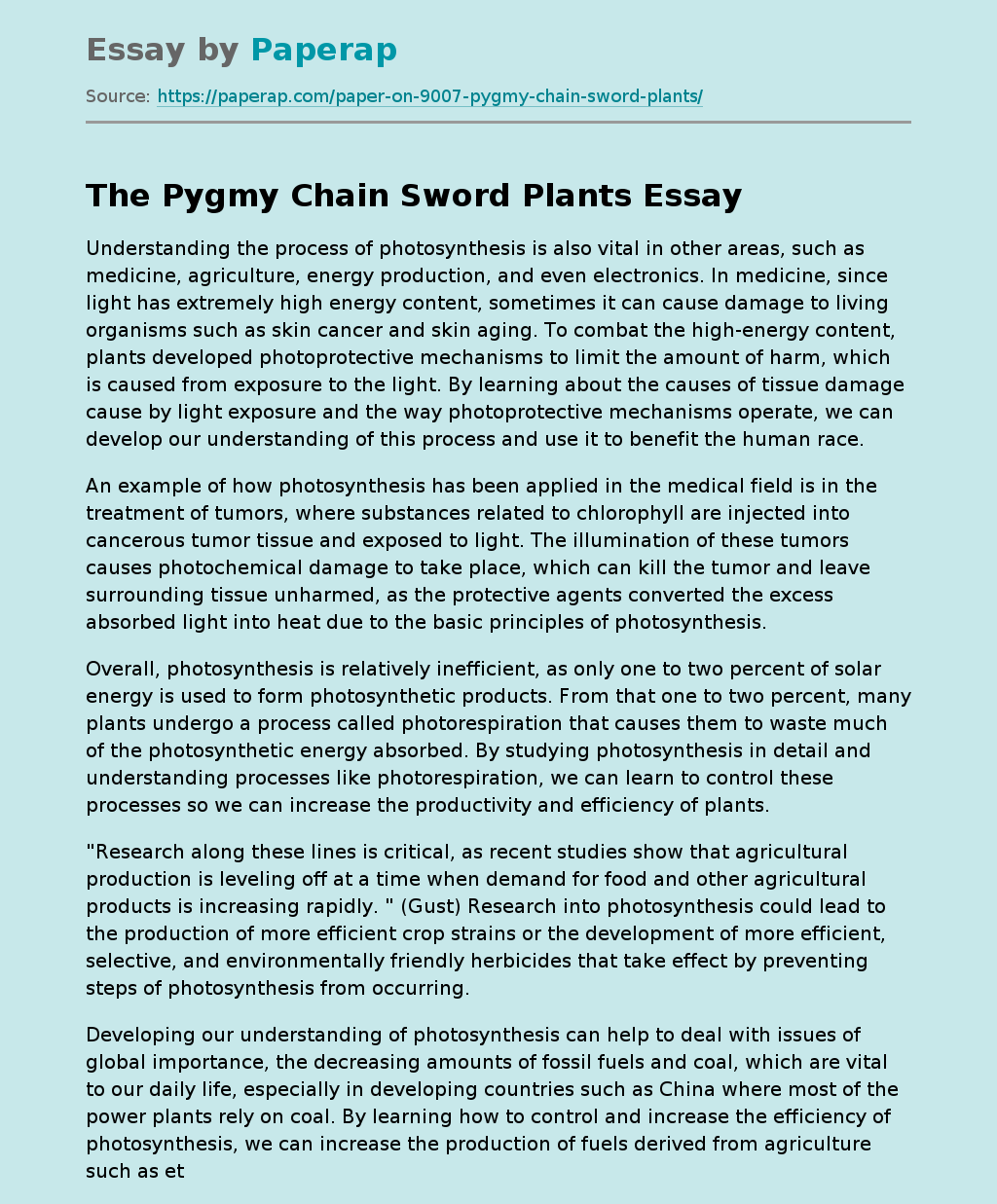The Pygmy Chain Sword Plants
Understanding the process of photosynthesis is also vital in other areas, such as medicine, agriculture, energy production, and even electronics. In medicine, since light has extremely high energy content, sometimes it can cause damage to living organisms such as skin cancer and skin aging. To combat the high-energy content, plants developed photoprotective mechanisms to limit the amount of harm, which is caused from exposure to the light. By learning about the causes of tissue damage cause by light exposure and the way photoprotective mechanisms operate, we can develop our understanding of this process and use it to benefit the human race.
An example of how photosynthesis has been applied in the medical field is in the treatment of tumors, where substances related to chlorophyll are injected into cancerous tumor tissue and exposed to light. The illumination of these tumors causes photochemical damage to take place, which can kill the tumor and leave surrounding tissue unharmed, as the protective agents converted the excess absorbed light into heat due to the basic principles of photosynthesis.
Overall, photosynthesis is relatively inefficient, as only one to two percent of solar energy is used to form photosynthetic products. From that one to two percent, many plants undergo a process called photorespiration that causes them to waste much of the photosynthetic energy absorbed. By studying photosynthesis in detail and understanding processes like photorespiration, we can learn to control these processes so we can increase the productivity and efficiency of plants.
“Research along these lines is critical, as recent studies show that agricultural production is leveling off at a time when demand for food and other agricultural products is increasing rapidly.
” (Gust) Research into photosynthesis could lead to the production of more efficient crop strains or the development of more efficient, selective, and environmentally friendly herbicides that take effect by preventing steps of photosynthesis from occurring.
Developing our understanding of photosynthesis can help to deal with issues of global importance, the decreasing amounts of fossil fuels and coal, which are vital to our daily life, especially in developing countries such as China where most of the power plants rely on coal. By learning how to control and increase the efficiency of photosynthesis, we can increase the production of fuels derived from agriculture such as ethanol.
A new experimental process carried out by scientists today involve making ethanol from trees, grasses, and crop wastes by breaking down the cellulose in woody fibers to form cellulosic ethanol. This is much more efficient as trees and grasses do not need to be replanted every year like grains. (“Ethanol made from,” 2006) By increasing our understanding of photosynthesis, we can cut down on our dependence on fossil fuels, and on the production of greenhouse gases, by increasing the production of ethanol as an alternate source of fuel.
Photosynthesis can even help in the development of technology, as engineers strive to make transistors and circuit components smaller in order to make computers faster and more compact, similar to how thylakoid membranes are packed inside chlorophyll molecules. Learning how plants control the movement of light energy to the different reaction centers and convert the light energy into chemical energy, can allow for the development of molecular-scale computers.
The reason why I chose this research question is that apart from my own personal interest in plants and my concern over the rising levels of pollution on earth, by understanding photosynthesis, the basis of life on earth, we can make medical and technological discoveries to improve our standards of living. Yet at the same time we can learn to control photosynthesis in order to increase the production of food and ethanol, and limit the amount of carbon dioxide in our atmosphere.
The Pygmy Chain Sword Plants. (2017, Nov 19). Retrieved from https://paperap.com/paper-on-9007-pygmy-chain-sword-plants/

